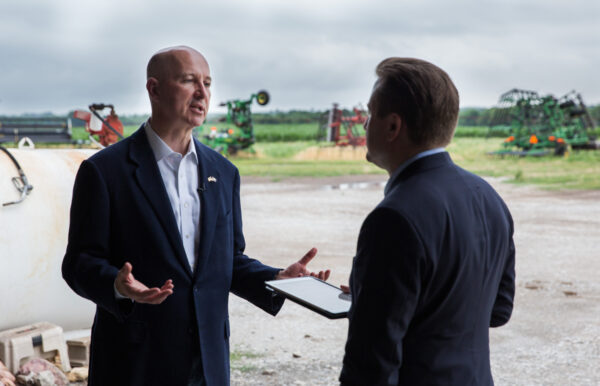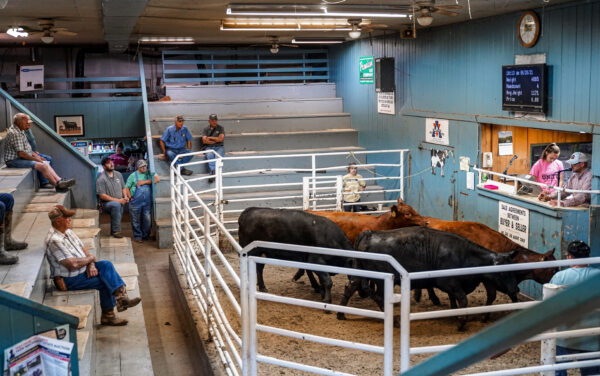It would be hard for Americans to miss that taking the family out for a steak dinner has become more and more of a luxury.
Wholesale price of beef was up some 40 percent in May, compared to the average in 2019, according to U.S. Department of Agriculture (USDA) data. Supermarkets and restauranteurs have partly absorbed the price increase and partly passed it on to customers.
Curiously, however, there seems to be neither a shortage of beef, nor a drop in demand. In fact, ranchers have so much cattle, they struggle to get it off their hands and meat packers, it appears, are running near capacity.
The unusual result is that small farmers struggle for survival even as packers haul in blockbuster profits.
The situation is tied to the CCP (Chinese Communist Party) virus pandemic and the government response to it. The initial outbreaks and lockdown measures disrupted beef processing capacity, creating a cattle glut that the industry still hasn’t cleared.
In addition, many Americans, shored up by unemployment and stimulus payments, are not too eager to pick up jobs. Meanwhile, trillions of dollars injected into the American economy are gradually being spent, bidding up prices of the products most in demand.
Finally, beef exports to China and other markets jumped in recent months, at least partially due to Argentina’s 30-day beef export ban instituted in mid-May to stymie soaring domestic beef prices.
Facing disappointing cattle prices and increasing feed prices, many American farmers have increasingly focused on alternative channels to get their beef to customers. They would team up with local meat lockers and offer the whole animal directly to consumers. Some even launched a project to build their own meat packing facility.
A March-April survey by Beef Checkoff, a marketing and research industry group, indicated that Americans plan to barbecue this year even more than in 2020, when the pandemic lockdowns forced people to stay home, prompting a massive grilling season.
With both prices and demand this strong, farmers are looking hard for ways to bypass the packers and market straight to consumers. That’s where local butchers and meat lockers come in.
Usually, a small meat locker business is hard to sustain. The USDA requires one of its inspectors to be present at all times at any meat processing operation that intends to market across state borders. The USDA charges establishments about $65 per hour for its inspectors, not including overtime and other surcharges. That’s a more than $100,000 annual cost of entry for a business. Even for local sales, a state inspection is necessary, which must be at least as demanding as the federal one.
Lockers have been using “Custom Exemption,” which allows them to slaughter and process without inspection as a service for the animal’s owner. The arrangement is such that the locker connects the customer with a farmer who sells the customer the whole calf, which is then delivered to the locker for slaughter. The locker then delivers the processed meat, usually deep-frozen, to the customer.
The advantage is that the customer knows exactly where the meat is coming from and can arrange for the animal as well as the cuts to be as he wishes. Does he prefer fattier, corn finished calf or a leaner, grass-finished one? Does he want more sausages or more hamburger patties? How thick should the steaks be? All that and more can be arranged.
In addition, the customer has the satisfaction of supporting usually a small, local farmer who earns substantially more on a custom animal.
Custom orders have been a lifeline for Rod Christen, a third generation cattle farmer in southeast Nebraska.
At a local sales barn, he can get about $1.18 for a pound of live calf weight. Through the local lockers he can get up to $1.85. Of some 300 calves he raises a year, about 20 would go directly to customers.
Recently, his business has been on the upswing, aided by online marketing.
“It seems like consumers locally do genuinely care about where their meat comes from and are starting to want to know the producers behind it and want to know how the cattle were raised and some of those things,” he told The Epoch Times.

With beef prices as they are, custom orders have become more attractive for customers economically as well. Christen calculated a consumer price of under $6 for a pound of meat. While certainly a premium for ground beef, it’s a huge discount on the prime cuts.
But there are some disadvantages too.
A whole calf translates to about 500 pounds of beef and another perhaps 200 pounds of fat and bones. That’s a huge delivery for a single customer. Only about 25 pounds are the most desirable rib and T-bone steaks. Another 80 pounds or so are the sirloin, porterhouse, and club steaks. The rest are various roasts and ground meat (pdf).
A common solution has been for several customers, such as an extended family, to band together to buy the animal. Some lockers also accept somewhat smaller orders and wait until they add up to a whole calf.
Christen said another problem is that with the increased demand, lockers have been swamped, resulting in appointments being scheduled a year in advance.
“To predict how many you can sell and to whom you’re going to sell them a year in advance is kind of like throwing darts at the board,” he said.
Yet another problem is that such orders need to be picked up in person by the customer or at best get delivered within a limited radius.
To get around such constraints, Nebraska farmers and other stakeholders have decided to build their own, mid-size packing facility in North Plate, about 70 miles east of the Nebraska-Colorado border.
A major facility would process about 5,000 calves a day. The investors are aiming for about 1,100 a day with completion by 2023.
They set up a company, Sustainable Beef, with a goal of helping local cattle farmers market their beef, especially to customers looking for an extra guarantee of quality and origin. One of their ideas is to use blockchain technology to ensure each cut can be traced to where it came from.
Nebraska Gov. Pete Ricketts supports the plan.
“Additional competition will be needed in the processing industry to make sure the kind of small calf-cow guys and feed lots can have some place to send their cattle and have some leverage,” he told The Epoch Times.

The plant is set to cost close to $300 million. It would employ over 800 people and buy cattle from about a 200-mile radius. Some 30 percent of its output would go to exports.
Guts of the Market
Meatpacking is the thankless industry that takes a 1,000-pound calf, slaughters it, and turns it into hundreds of steaks, roasts, sausages, stew bones, and hamburgers for Americans to boil, broil, and barbecue. For a long time, the industry has been marked by overcapacity, always scrambling to get enough cattle to keep the lines running. Ranchers thrived on the ever-present demand.
Over the past several decades, the industry has consolidated and downsized, resulting in most of the processing falling into the hands of just four companies: JBS, Cargill, National Beef, and Tyson.
In recent years, the packers have been slaughtering about half a million calves a week. They mostly buy from large feedlots that take 700-pound calves from ranches and feed them corn until they reach the optimal weight.
It used to be that feedlots bought most of the cattle through negotiated cash transactions, such as through auctions at local sales barns. Now, they buy about 80 percent through alternative arrangements that price calves based on formulas that include quality criteria and cash prices from the week before.
The alternative marketing is more efficient, saving money for every party involved, including the farmers, according to research by Stephen Koontz, agriculture professor at Colorado State University and expert on beef markets.
But many farmers have complained that there are so few bidders at local sales barns the prices get artificially depressed.

There’s a bipartisan bill in Congress that would mandate at least 30 percent of cattle trade be done in the cash market. Koontz considers that excessive.
He acknowledged that very little trade now occurs at auctions, but said the 20 percent of cattle still sold through negotiated cash transactions is more than enough for effective price discovery.
“Sometimes the right price takes one trade and sometimes it takes a hundred. Of course, more is better but sometimes the marginal value of that second trade is zero—and while more is better, it is also certainly more expensive,” he told The Epoch Times via email.
The question of “how much cash trade is needed” doesn’t have a simple answer, he said.
“Sometimes it’s a lot and sometimes it’s very few. And the evidence is that we can do fine with very, very few transactions.”
He would prefer the industry to set up its own rule-making institutions, similarly to the stock exchange. The industry could, for example, pay some of the large players to act as “market makers” who would be obliged to be always ready to buy or sell cattle, similarly to how stock exchange market makers ensure liquidity.
“More detailed trading institutions are better than a mandatory cash minimum,” Koontz said.
The packers have a natural advantage in the market as they can slow down or speed up their processing lines on relatively short notice. Farmers, on the other hand, need to plan their production years in advance. When the cattle reach their optimal weight, they need to be sold quickly as they lose value if they get too old and fat.
Many farmers suspect the big packers are colluding and using their market influence to depress cattle prices.
“If you get two buyers in the crowd and they sit next to each other and they say, ‘Ok, you can take this load, you take that load,’ well, that’s not competition, you know. They’re taking turns buying. And that’s kind of what’s happening on a larger scale with major packers. It’s the way we see it anyway,” Christen said.
About a dozen state attorney generals requested a Department of Justice investigation into the matter last year. President Donald Trump backed the request and the investigation is still underway. In May, six governors, including Ricketts, urged for the investigation to continue.
None of the big four meatpacking companies responded to requests for comment.


